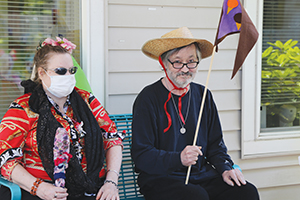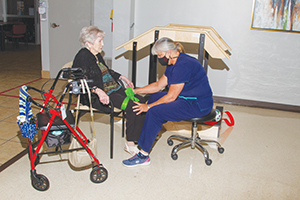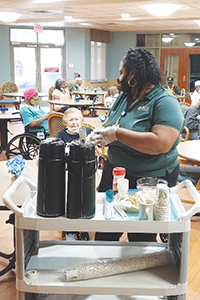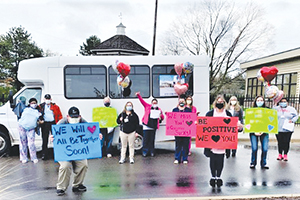Providers flip their operating model to provide more services at home
By JULIE MINDA
During the worst of the pandemic and prior to being vaccinated against COVID-19, Vivian Collick, 79, of Philadelphia, was afraid to venture out of her senior living apartment complex for supplies or medical care.

Thankfully, as a participant in the Mercy LIFE Program of All-Inclusive Care for the Elderly, she had a safe and reliable lifeline. Staff of that Trinity Health PACE program called frequently to check in on her and ask her what she needed. They delivered medications so she wouldn't have to go to a drugstore, and they sent nurses to her apartment for health checks. "It put my mind at ease, not having to go out to go to the (PACE) center and not having to go out where I could get COVID," Collick says.
She is one of more than 55,000 PACE participants nationwide, the vast majority of whom have stayed safe and healthy in their residences during the pandemic through the support of PACE, according to the National PACE Association.
At the pandemic's chaotic start, PACE providers from the Catholic health ministry pivoted quickly from providing services from a central hub to providing most services in clients' homes or by telehealth. A study by the National PACE Association says most PACE clients have fared better in terms of COVID case rates and mortality rates than their peers in nursing homes during the pandemic. Ministry PACE providers credit staff ingenuity and commitment for this.

Brian Cooper, vice president of PACE operations for Ascension Living, says, "We discovered that we have some very creative and talented associates that have really stepped up to the plate to find compassionate and thoughtful ways to provide for the needs of our participants while also keeping them and our associates safe."
Flipped script
Normally, PACE programs operate from one location, providing a wide range of recreational, social, medical, mental health, nutritional and spiritual services (see sidebar) to clients in a center, with other services provided on an ad hoc and limited basis in clients' residences.
When the pandemic began, PACE programs had to "turn this model upside down," says Susan Tuller, executive director of Providence ElderPlace in Seattle.
Following state and local guidance and/or the direction of their parent systems, the PACE programs had to temporarily suspend attendance at their centers and rapidly determine how to maintain all the essential services while keeping PACE participants safe in their homes. They came up with workarounds in keeping with guidelines from government health agencies and direction from the National PACE Association.
"We revamped our way of thinking," says Chad Whitehead, program integrity manager at St. Bernards Total Life Healthcare, a PACE program in Jonesboro, Arkansas.
The vast majority of the PACE programs whose representatives were interviewed for this article shut their adult day programs for several days or weeks early last year to put infection prevention protocols in place that would allow them to reopen their day care programs to the frailest patients, many of whom had dementia and were deteriorating rapidly at home owing to the isolation.
The centers remained closed to most clients for several months to over a year depending on local infection rates. The programs have been redeploying staff to deliver essential services in participants' homes or via telemedicine when their clients can't come into their centers.
As vaccination levels have risen and infection levels have decreased this year, the day centers have slowly been increasing capacity to allow more clients to come in. The PACE representatives who spoke with Catholic Health World say that while they are monitoring the highly infectious delta strain of COVID now spiking infection rates in parts of the U.S., at this point renewed scale-backs of in-person services have not been necessary.
Uninterrupted service
At the onset of the pandemic, ministry PACE center teams developed service delivery plans that prioritized client and staff safety, scrambled to secure hard-to-find personal protective equipment for all staff as well as for clients who needed it, divvied up client lists so team members could do wellness checks by phone or home visit, stratified their client lists by urgency of need and strategized how to meet those needs.

Close communication proved essential. Providence ElderPlace PACE locations in Washington and Oregon used donations and grants to purchase 125 GrandPads tablets so clients able to use the technology could communicate from home with PACE staff and with loved ones.
Government agency guidance dictated to what degree and when PACE centers could reopen in each state. Several of the PACE representatives interviewed for this article say they have been keeping their medical clinics open on a very limited basis for critical client needs only. To maintain social distancing and minimize infection risk, some PACE programs have been allowing only one client into their medical clinics at a time. Telehealth visits replaced in-person health checks for many.
In addition, PACE frontline workers are coming to clients' homes to provide medical care, socialization and check-ins. Staff is delivering groceries and other necessities to some clients. Many PACE programs deliver hot meals or microwavable meals to clients who would have dined at the center prior to the pandemic.
Cooper of Ascension Living says this flexible approach is enabling PACE providers to maintain uninterrupted care and support for clients.
Vaccine scramble
Carrie Hays McElroy, chief clinical and compliance officer at Trinity Health PACE, says that when COVID vaccine rollouts began in late 2020 and early 2021, PACE providers did not fit neatly into the categories of nursing home operator, hospital, pharmacy or other organization qualified to obtain and dispense vaccines.
McElroy says PACE centers to secure appointments at community vaccination sites and get clients there.

All these ministry representatives say their PACE programs have vaccination compliance levels upwards of 75% among clients.
When it comes to staff, Ascension and Trinity Health are mandating vaccination and St. Bernards is strongly encouraging it. All Providence St. Joseph caregivers are required, where permitted by state law, to get vaccinated and show proof of vaccination, according to the system. Those unable to be vaccinated will be required to sign a declination and follow additional protocols. Requirements may include enhanced COVID testing, mandatory vaccine-related education/discussions, and/or other infection prevention steps in accordance with Providence St. Joseph's policy, CDC or state and local public health government mandates.
Safe and sound
According to a survey reported in February by the National PACE Association, both the COVID case rate and the COVID mortality rate for PACE participants are one-third the rate for nursing home residents. The ministry PACE representatives say their programs saw similar results, and they add that they also had consistently low emergency department admission rates, hospital readmission rates and fall rates for PACE participants during the pandemic.
Becky McDaniel, St. Bernards executive director, notes, however, that there was some decline in participants' overall physical and mental health because of the cutoff from day center participation. She says the gradual reopening of day center services now is enabling some clients to regain some lost function.
Tuller of Providence PACE says the successes the programs have achieved in maintaining clients' health and safety are a validation of PACE's intent and design to keep people safe and functioning at their fullest capacity at home.
Daniel Drake, president and chief executive of Trinity Health PACE, says since many PACE programs proved their value over the last year and a half, some states that had eschewed the program in the past or had undervalued it, are taking a second look. "It was a tough time, but our colleagues really gave it their all. We embraced new ways of serving" our clients that reaped positive results, and those new approaches will remain in use in the future.
PACE model offers support to keep frail seniors in the community
Developed in the San Francisco area in the 1970s, the PACE program enables nursing home-eligible people aged 55 years and over to receive services and support so they can remain as independent as possible. For lower-income individuals, who make up 90% of PACE enrollment nationally, the voluntary program is funded through Medicare and Medicaid.
PACE stands for Programs of All-Inclusive Care for the Elderly. According to the National PACE Association, the PACE model is centered on the concept that "it is better for the well-being of seniors with chronic care needs and their families to be served in the community whenever possible."
Normally, PACE programs operate on a hub and spoke model, with most clients receiving shuttle transportation to a center where they get care and services from a multidisciplinary team. At such centers, participants normally can receive adult day care; physical, occupational and recreational therapies; meals; nutritional counseling; medical care provided by a PACE physician; prescription drugs; social services; medical specialties, such as audiology, dentistry, optometry, podiatry and speech therapy and mental health care. The PACE team also provides clients access to home care, emergency or hospital and nursing home care when necessary.
There are 140 PACE organizations in 30 states. About two dozen of those organizations are wholly or partially sponsored by Catholic organizations.
Government agencies becoming more receptive to PACE
State governments have not always been interested in supporting and investing in Programs of All Inclusive Care for the Elderly because the program requires the investment of both state and federal dollars, and states are not always willing to commit to the outlay.
PACE programs get money from Medicare and Medicaid on a per client per month basis and direct their clients' care along a care continuum. The program was created to allow frail seniors whose condition would qualify them for a Medicaid-funded bed in a nursing home to stay in the community where care is less expensive, and age safely at home with supportive services.
Most, but not all, states embraced the program. Thirtyone states currently have PACE programs. Some states with tight purse strings now are seeing the value of directing some of their Medicaid budget to PACE programs. Much of the shift is due to states' observance of happenings during the pandemic.
That is according to Daniel Drake, president and chief executive of Trinity Health PACE.
His observation is in line with recent coverage in Home Health Care News, an online industry newsletter covering the home care industry that is owned by the Aging Media Network. That newsletter reported July 25 that federal legislators also are looking to support PACE expansion, and some legislation is receiving "a warm reception from industry insiders," says the story.
Sen. Bob Casey, D-Pennsylvania, chair of the Senate Special Committee on Aging, introduced the PACE Plus Act in April to provide federal grants to expand PACE programming. If passed, the legislation would lessen bureaucratic burdens that have hampered PACE's growth in the past, according to Home Health Care News.
In a release about the legislation, Casey said, "If we have learned anything from the pandemic, it is that people want options of where to receive their care and expanding the PACE program will make it easier for states to offer home-based services to people who have complex medical needs."
The Home Health Care News notes states' new openness to the PACE model.
PACE center staff liven clients' lives, reduce isolation during pandemic
A key focus of the Programs of All Inclusive Care for the Elderly model is maintaining senior adults' well-being from a holistic perspective, that includes making an effort to ensure that people socialize and enjoy themselves. With PACE centers closed or significantly limited in terms of the number of clients they could host in-person during the pandemic, staff got creative to stimulate and entertain clients not able to come to the center for group activities.
To break through the isolation and bring joy to clients' days, Ascension's PACE Michigan staff streamed recreational programming through a private Facebook group for clients, and they organized car parades to go by their homes. Ascension's Wichita team surprised PACE participants at their homes with "reverse trick or treating" last Halloween and with holiday car parades at Christmastime.
Brian Cooper, vice president of PACE operations for Ascension Living, says care teams with Ascension's PACE programs in Chattanooga, Tennessee; Wichita, Kansas; and Flint, Michigan, made visits to clients' homes and stayed in touch with clients' loved ones.
Tina Hayes, manager of the PACE center affiliated with St. Bernards Healthcare in Jonesboro, Arkansas, says that center's team sent participants crossword books and other activities to do at home.
Chad Whitehead, program integrity manager of St. Bernards Total Life Healthcare, says that the PACE team also asked clients' permission to share their contact information with other PACE clients so friendships could be maintained.
Carrie Hays McElroy is chief clinical and compliance officer at Trinity Health PACE, which operates one of the nation's largest group of PACE programs. Trinity Health PACE sites are broadcasting virtual bingo, virtual cooking classes and other activities.
The PACE programs of Franciscan Missionaries of Our Lady Health System in Baton Rouge, Louisiana, have used Zoom extensively for recreational activities for participants, says Wendy Taylor, senior director of Franciscan PACE, that health system's PACE program. PACE staff have read newspaper articles to clients over Zoom. PACE's spiritual care staff has used the Zoom connection for recitation of the rosary and to broadcast talks on spiritual topics.
While these PACE leaders note that these approaches have helped to keep clients engaged and connected, they acknowledge that the virtual connections do not substitute for the in-person experience in the day centers. They say clients have been eagerly awaiting the fuller reopening of the day centers, and as more people are welcomed back as capacity limits rise, the PACE staff are witnessing joyful returns.
Taylor says some clients shed tears of joy when they step back into the day centers.
Daniel Drake, president and chief executive of Trinity Health PACE, recently got a letter from the daughter of a PACE participant who had just returned to in-person participation at one of Trinity Health PACE's centers. She wrote that her mother was euphoric about her return and had been so excited about her return that she'd missed a bit of sleep the night before her first day back.
"It's all about the socialization," Drake says.
